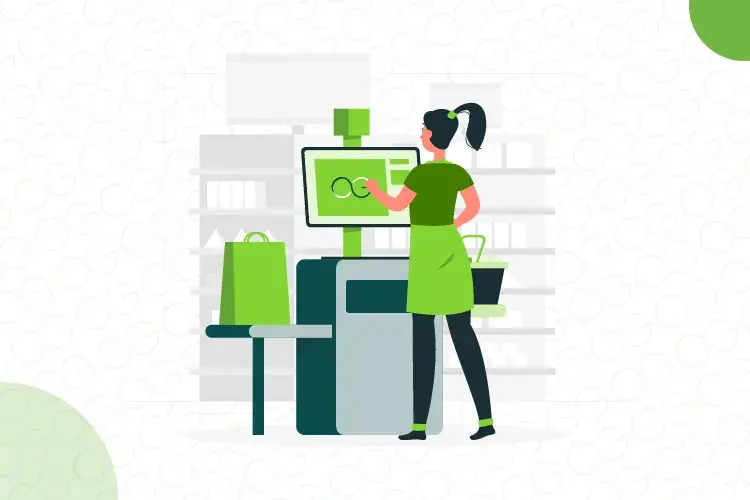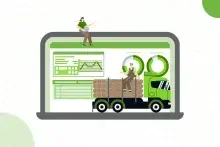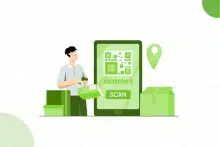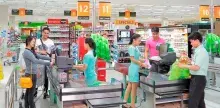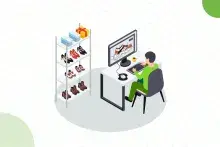Exploring Self-Checkout POS: Perception vs Reality
Imagine you're in a busy grocery store with people bustling around, shelves filled with all sorts of things. You are shopping for a big gathering at home, so you fill your basket full of groceries. As you approach the checkout area, your eyes catch the self-checkout station at one corner. At the self-checkout, a friendly screen welcomes you. You quickly scan each item, and to your delight, the screen provides detailed information about each product. A cheerful voice suggests discounts or reward points. Effortlessly, you navigate through the system, and with a sense of satisfaction, you finalize the payment. The entire self-checkout experience proves to be a seamless journey, leaving you appreciative of the valuable time saved and the rewards earned. This is how the self-checkout system for grocery stores streamlines the process, saving time and enhancing overall satisfaction in grocery shopping for both customers and the business.
Today, customers crave quick and seamless checkout experiences. According to the National Retail Federation’s survey conducted in 2023, 62% of people hate to be in a long queue when checking out and they might love self-checkout systems in retail operations. This system helps retailers save costs while delivering a better customer experience. In the study of Statista in 2022, 46.5% of US and UK convenience stores and pharmacy retailers feared losing customers to competitors with scan-and-pay options. This is why retail self-checkout machines have started attracting tech giants like Amazon and Walmart.
This article explores the benefits of self-checkout systems and how to implement them in your retail store.

Revolutionize Retail: Self-checkout Unleashes Seamless Shopping Experience.
Perception of Self-Checkout Point of Sale (POS)
1. Customer Perception
- Difficulty of Use: Self-checkout POS is often perceived as a challenging system to use, understand, and operate.
- Speed Concerns: Some customers think that self-checkout is less speedy than traditional cashier-assisted lanes.
- Mixed Feelings: A subset of customers embraces self-checkout POS for the sense of independence and control it offers while others find it complicated.
- Adoption Rates: Adoption rates differ among different demographic groups. Younger, tech-savvy customers may find self-checkout more intuitive, while older customers might encounter difficulties.
2. Retailer Expectations
- Cost Savings: Retailers anticipate cost savings through the implementation of self-checkout POS systems.
- Improved Efficiency: Businesses continue to grapple with the realization of how self-checkout technology can truly elevate their overall operational efficiency.
- Enhanced Customer Experience: Retailers accept that a self-checkout system will enhance customer satisfaction and foster customer loyalty.

The Future of Retail: Redefining Self-checkout for Efficiency

Reality of Self-Checkout POS
1. User Experience
- Positive Reactions: Users prefer self-checkout POS for its speedy and convenient experience, leading to high satisfaction levels.
- Adoption Rates: This system has user-friendly navigation facilitated by technologies such as voice guides, ensuring seamless assistance, catering to the ease of use, even for older customers
- High speed: With its seamless design and integrated technology, the POS system enhances the checkout process, ensuring swift and effortless transactions.
2. For retailers
- Increased Efficiency: Many retailers observe success in terms of increased operational efficiency.
- Speed: Self-checkout systems in retail reduce wait times, especially during peak hours, leading to a smoother shopping experience.
- Cost Savings: The ability to handle more transactions with fewer human cashiers contributes to reduced labor costs and increased profitability.

Know Self-Checkout POS: Perception vs Reality
Benefits
1. For customers
Increase customer satisfaction: Self-checkout POS software enhances customer control, allowing them to complete shopping in under 4 minutes.
- Quicker Checkout: Self-scanning locations often have shorter lines than cashier stations, allowing customers to pay and leave the store more quickly.
- Multiple Payment Options: The systems can accept multiple payment options such as cash, debit, credit, and mobile payment apps like Apple Pay.
- Shorter lines: The long checkout line is the top customer pain point based on a customer survey by Capgemini in 2019. Through self-checkout POS systems in grocery stores and other retail stores, retailers can lower wait times and reduce the queue in checkout lanes.
- Privacy: Some customers appreciate the privacy that self-checkout provides, as they can complete their transactions without direct interaction with a cashier.

Benefits of Self- Checkout POS: Faster than a Cashier, Friendlier than a Line

For business
Increased operational efficiency: With self-checkout systems in retail, one employee can watch multiple systems at the same time. This can help your staff save time to take on other activities instead of standing behind the cashier lane.
- Reduce labor cost: With self-checkout POS solutions, fewer cashiers are needed, allowing businesses to allocate human resources more efficiently.
- Retrench of space: Self-checkout systems take up less space than regular checkout registers. This means you can place many machines into a smaller area while your checkout capacity remains the same.
- Hygiene and Safety: Self-checkout is a safer option by minimizing direct human contact during the transaction process, especially during events like the COVID-19 pandemic.

With Ginesys Experience the Benefits of Self-Checkout POS
Future Trends and Innovations
The self-checkout POS systems are facing continued advancements and innovations driven by emerging technologies. Let us see some of the technological advancements:
1. Visual Recognition of Items:
- Object Recognition Technology: This involves advanced cameras and sensors that can identify products without the need for barcodes.
- Computer Vision: By utilizing computer vision algorithms, you can enhance the accuracy of identifying items, reducing errors and increasing the efficiency of the checkout process.
2. RFID Technology:
- Widespread RFID Adoption: RFID tags on products can streamline the checkout process further by allowing for quick and contactless identification of items.
3. AI and Machine Learning:
- Dynamic Pricing and Personalization: AI can analyze customer purchasing behavior and offer personalized promotions as well as discounts in real time.
- Predictive Analytics: Machine learning algorithms can be employed to predict customer preferences, and anticipate demand patterns, leading to more efficient operations.
4. Integration with Mobile Devices:
- Mobile Checkout Solutions: Customers can finalize complete transactions using their smartphones.
- Contactless Payments: A seamless, contactless, and secure payment experience is facilitated with the integration of mobile wallets.
5. Enhanced Security Measures:
- Biometric Authentication: Enhance security and reduce the risk of unauthorized transactions by implementing biometric authentication methods, such as fingerprint or facial recognition.
- Advanced Fraud Detection: Fraud detection systems with AI can analyze different patterns of behavior and identify potentially fraudulent activities. This adds an extra layer of security.

Conquer the Landscape of Retail with Innovations of Ginesys
3 Critical strategies for our retail clients
1. Measure front-end customer experiences and their impact on overall CSAT:
- Importance of Measurement: Establish robust systems to measure and analyze front-end customer experiences.
- Key Metrics: Key performance indicators (KPIs) provide insights into areas that need improvement.
- Integrated Approach: Prioritize improvements by understanding the correlation between specific customer interactions and overall satisfaction.
2. Think of Self-Service as an Experience, Not Just a Technology:
- User-Centric Design: Approach self-service solutions with a user-centric mindset. Prioritize intuitive interfaces, clear instructions, and a seamless user experience.
- Educational Support: Provide comprehensive educational support for customers engaging with self-service options. This can include in-store tutorials, online guides, and proactive assistance through chat.
- Continuous Improvement: Regularly gather feedback on self-service tools and iterate based on customer input. Embrace emerging technologies to enhance the self-service experience continually.
3. Develop a Specific, Self-Service In-Store Strategy:
- Customized Solutions: Tailor self-service strategies to match the unique characteristics of each retail client. Consider factors such as the type of products or services offered, demographics, and existing technological infrastructure.
- Staff Involvement: Train store staff to assist customers with self-service options and address any issues promptly.
Implementing these strategies will contribute to a more positive customer experience, higher satisfaction levels, and improved overall efficiency in retail operations.
Challenges and Solutions with Ginesys One
Ginesys stands out as a cutting-edge enterprise for ERP software in the dynamic landscape of retail businesses. Ginesys One suite's self-checkout Point of Sale (POS) system – Zwing that is basically a cloud POS, has a myriad of features and seamless integrations to meet the evolving needs of the industry. These robust functionalities empower retailers to effortlessly implement and oversee self-checkout systems.

Navigate through the World of Self-Checkout POS with Ginesys’s Innovative Strategies

Let's delve into the challenges encountered by retailers in self-checkout POS software and explore how Ginesys not only addresses them but elevates the entire self-checkout process.
| S.No | Challenge Description | Ginesys Solution |
|---|---|---|
| 1 | Item Recognition Issues | Under Research |
| 2 | Payment Processing Errors |
|
| 3 | User Interface Complexity |
|
| 4 | Security Concerns | Multi-level authentication and authorization protocols. |
| 5 | Technical Glitches and Downtime |
|
In conclusion, the retail self-checkout system has emerged as a transformative force in the retail landscape, revolutionizing the traditional grocery shopping experience for both customers and businesses. Contrary to initial concerns, self-checkout POS software delivers positive user experiences, enhances retailer efficiency, and offers mutual benefits.
With Ginesys One’s self-checkout POS – Zwing, you can experience seamless transactions, streamlined operations, and a heightened level of customer satisfaction, marking a new era in modern retail technology. Ginesys Cloud POS emerges as a definitive solution to the challenges faced by retailers in self-checkout POS systems. Our platform provides a holistic and personalized approach to enhance the entire self-checkout process.

Elevate your retail experience with Ginesys One and embrace the future of seamless and efficient self-checkout.
FAQ's
1. Do you have easily scannable barcodes?
Ginesys cloud POS ensures that all products in your store have scannable barcodes which are easily readable by the self-checkout system.
2. Is my storage space suitable?
We evaluate the layout of your store to ensure there is enough space for self-checkout stations without causing congestion.
3. Do you have suitable hardware?
Ginesys does not provide any self-checkout hardware including scanning devices, payment terminals, and bagging areas. The hardware chosen should be able to handle a variety of products, including those with irregular shapes or sizes.
4. Do you have the right software capabilities?
We Implement robust software that can handle various payment methods, and track inventory. It can also integrate with your existing POS system. The self-checkout POS software is user-friendly for customers, providing clear instructions and prompts throughout the checkout process. Regular updates and maintenance are also provided to address any software issues or security vulnerabilities.
